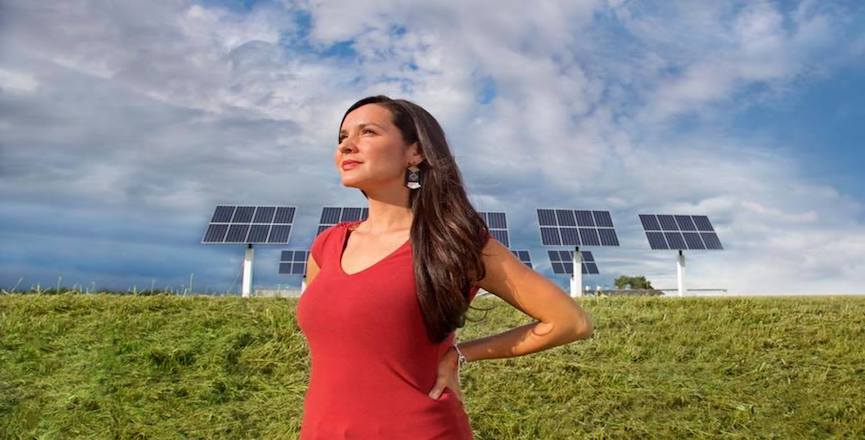Growing up in a First Nations community in northern Alberta with neither paved roads nor running water, Melina Laboucan-Massimo noticed a pattern. Once young people reached their teenage years, many would need to leave the community, either to find jobs or get an education. For years, the only option for youth in her community of Little Buffalo seemed to be working in Alberta’s oil and gas industry. She often dreamed of launching an initiative that would bring jobs and education to the community.
A massive oil spill near Little Buffalo, contaminating the water and land on which the Lubicon people have lived since time immemorial, served as a catalyst. “This spurred me to get involved in the transition to a post-oil economy,” says Laboucan-Massimo. “A just transition, one that makes sense for my community.” As part of her graduate studies, she proposed building a solar power generation project, which became the Pîtâpan (Cree: ‘Coming Dawn’ or ‘New Dawn’) Solar Project.
“Renewables are much more in line with Indigenous understanding and principles,” Laboucan-Massimo notes. “Our relationships with Mother Earth are reciprocal.”
It was decided that the 20.8kW system would be installed in the summer of 2015 and located in the heart of the community. “It was very important that the project was visible in the community, not on some land far away,” Laboucan-Massimo adds. “We went around beforehand, consulting the elders and showing photos of what it would look like and explaining how exactly it worked.” A community engagement meeting with band members verified that the people themselves supported the project.
“We are tired of being economic hostages in our own homeland,” says Laboucan-Massimo.
This is all part of a wider process of healing and transition. For decades, the Lubicon people have engaged in struggles with the federal and provincial governments and private corporations to defend their land and protect their way of life. KAIROS and its member churches have mobilized in solidarity with the Lubicon people for land rights and self-determination on countless occasions. Financial support for Pîtâpan was provided by a variety of environmental and renewable energy groups, among other private donors.
Laboucan-Massimo is hopeful when she sees other First Nations engaging in similar actions. As just one example, the Batchewana First Nation’s full commercial partnership in the Bow Lake Wind Facility has created seven full-time jobs and generates revenue of approximately two million dollars per year.
Looking forward to even bigger opportunities, Laboucan-Massimo wants the Alberta government to facilitate installations of much larger solar projects that generate 1 MW or more. Currently the provincial government assists First Nations communities with solar projects of less than 1 MW and provides up to 60 per cent of the capital costs. Laboucan-Massimo points out that Ontario’s Green Energy Act promoted First Nations ownership of clean power projects on their territory; and with the federal government announcing a national price on carbon pollution, she foresees new opportunities for financing clean power generation projects with Indigenous peoples.
According to Laboucan-Massimo, community ownership of power systems is a key ingredient of a just energy system. Making the transition work for marginalized communities requires decentralizing the generation of power. She also places value on a realignment of politico-economic power.
“We’re not looking for a clean energy grid that’s owned by big corporations like Suncor or Enbridge but by communities that actually own their power.”
See the Pîtâpan Solar Project come to life in the video below, Just Transition: Solar in Indigenous Communities. Learn more about the Lubicon Solar and the Pîtâpan Solar Project.
This is the first blog of an ongoing series by KAIROS Canada called New Economy Trailblazers.
Image: Melina Laboucan-Massimo/Facebook
Like this article? Please chip in to keep stories like these coming.




